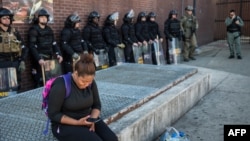The unrest in Baltimore once again demonstrated that social media is a double-edged sword, serving as a fast medium to spread both helpful information and potentially destructive misinformation, experts say.
From calls to violence to acts of kindness, platforms like Twitter, Instagram and Facebook lit up with real time reports from Baltimore’s enraged streets.
“Social media makes everything messy,” said Janet Johnson, a social media researcher at the University of Texas in Dallas, adding that most of what she’d seen come out of Baltimore on social media was positive, such as the video of the woman scolding her son for rioting and African-Americans forming a line between violent protesters and police.
One way social media makes things messy is that anyone can tweet from anywhere blurring the lines of fact and fiction, analysts say.
According to one report on Fox News, “between 20 and 50 social media accounts in Baltimore that were also tied to the peak period of violence in Ferguson.”
Perhaps the messiest thread of social media chatter centered on a 2013 movie called “The Purge.” In the movie, the police take one night a year off, allowing criminals to rampage with impunity.
Initially, it was reported that a message on social media encouraged Baltimore high school students to head to a local mall Monday afternoon to “purge.” At the mall, the students were met by police who had also seen the purge message on social media. What followed was a night of violence.
Later reports claimed the students were “set up” by the police.
Gangs were first accused to inciting violence over social media, specifically that they had made a truce to harm police officers. Later, gang members denied that and, in fact, called for calm.
The Baltimore police also utilized social media to try to influence events.
The department took to Twitter to inform people of dangerous areas and to appeal for peace.
Baltimore’s riots showed that even the best intentions can backfire on social media.
One example was popular grocery chain Whole Foods. One Baltimore outlet posted a photo of National Guardsmen receiving sandwiches from the store.
That sparked some angry comments directed at the retailer.
“Who knew that them trying to help first responders would get them negative publicity,” said analyst Johnson, noting that on social media in particular, opinions are often very polarized.
Another social media explosion occurred with the arrest of a protester, Joseph Kent, on live TV. A passing vehicle obscured the last moments Kent was on the streets, leading many to say he had been kidnapped.
It was later revealed that Kent had been taken to jail and released this morning.
For many Americans, Baltimore is most well known for being the setting of the popular television series “The Wire,” which portrayed Baltimore as a tinderbox of drugs, poverty, strained race relations, corruption and crime.
Not surprisingly, social media was filled with references to the show, including some comedic takes.
Johnson said she thought that too often the mainstream media uses social as a driver of their coverage, “taking it as the story people want to see.”
“Instead of finding the facts, everyone wants to be first instead of right,” she said.








